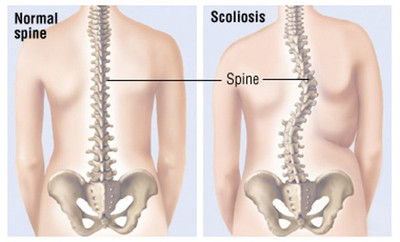 18th Sep 2015
18th Sep 2015
How to Treat Scoliosis Symptoms with Physical Therapy
Scoliosis is a condition that affects the normal shape of the spine, altering a person's overall trunk alignment and posture. Scoliosis causes the spine to move to the side and turn. This condition can occur at any time during the lifespan, but is more commonly detected during adolescence. Scoliosis ranges from mild to severe cases, requiring a variety of treatments, with severe Scoliosis requiring surgery. The Scoliosis Research Society defines scoliosis as a curvature of the spine to the side that also includes rotation. Scoliosis causes postural and trunk alignment changes that cannot be corrected by merely “standing up straight”. On an x-ray, the spine may appear to have an "s" or "c" shape.

Physical Therapy can help patients suffering from Scoliosis
Scoliosis is usually a pain-free condition, but pain may occur as the spine curves abnormally and affects the surrounding muscles and joints. These changes may alter a person's alignment, posture, and movement patterns, causing irritation and pain. Muscles that usually support the spine may become imbalanced in scoliosis, leading to a loss of strength and flexibility. A person with scoliosis may experience:
- Uneven shoulder height.
- Uneven hip height.
- An uneven waistline.
- A general sense that the 2 sides of the body don't line up.
- Pain in the areas surrounding the spine, including the shoulder, pelvis, and hip.
- Pain with specific movement or activity.
Physical therapy can help patients with scoliosis, with the primary goal being to help the individual restore and maintain mobility so they can function at their personal best, and improve their quality of life. With that in mind, a personalized treatment plan will be created using a variety of the following techniques:
Top 5 Physical Therapy Modalities for Scoliosis Symptoms
- Range-of-Motion Exercises: The physical therapist will design a gentle range of motion treatment program in order to prevent limitations and increase the body's range of motion.
- Strength Training: Treatment will include exercises designed to strengthen any muscles surrounding the spine or in other parts of the body that have been weakened by the change in the spine’s position, such as the hips, shoulders, or even the head and feet.
- Cold Compression Therapy: One of the most basic treatments to alleviating pain and discomfort associated with having Scoliosis is cold therapy. Cold therapy can decrease pain by limiting the pain fiber transmission and nerve conduction. Cold compression units use air pressure which wraps the body for better surface contact, allowing the system to pull heat away from the injury site more efficiently and enhancing the effects of cold therapy.
- Transcutaneous electrical muscle stimulation (TENS): Much of the pain from adult degenerative scoliosis is the result of muscle spasm. Spasms occur when the normal muscles must work harder than normal try to restore the balance to the spine. The muscles then become fatigued and begin to spasm, causing pain. TENS units work by sending stimulating pulses across the surface of the skin and along the nerve strands, preventing pain signals from reaching the brain. This will help stimulate the body to produce higher levels of its own natural painkillers, Endorphins, helping reduce pain associated with muscle spasms.
- Ultrasound Therapy: Ultrasound can also be used in controlling the pain in back muscles. Duration and frequency of ultrasound in the adult scoliosis patient is going to vary, but several studies indicate that ten minutes of therapeutic ultrasound 2-3 times per week for 3-4 weeks resulted in a significant reduction of pain.
A Combination Therapy like the ComboCare from Current Solutions
provides both TENs and Ultrasound for verstile treatment
While Scoliosis won’t be cured with physical therapy, the sometimes debilitating pain associated with it can be. Additionally, working with a physical therapist will help patients with Scoliosis not only maintain their functionality, but lower the need for surgery while improving their quality of life.






